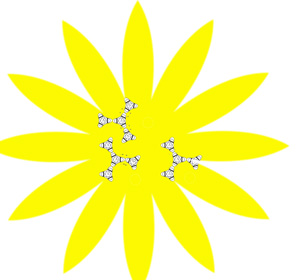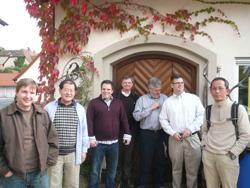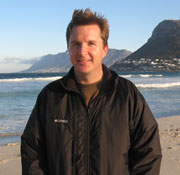We are delighted and thrilled to announce that Professor Philip Mountford, from the University of Oxford, UK, has been appointed as the new Chair of the Dalton Transactions Editorial Board, with effect from 1st January 2012.
Philip’s research interests centre around studies of the bonding and stoichiometric and catalytic reactivity of organometallic and related compounds of the early transition and lanthanide metals, and, more recently, the alkaline earth metals. This research has a particular emphasis on compounds with metal-nitrogen multiple bonds, olefin polymerization and ring-opening polymerization towards “green” polymers. Philip is a Fellow of the Royal Society of Chemistry and a past recent recipient of the RSC’s Sir Edward Frankland Fellowship. He has been a Visiting Professor at several European universities and recently served as Acting Head of Inorganic Chemistry in Oxford.
Of his forthcoming role, Philip says: “I am delighted and honored to be taking over from Chris Orvig as Chair of the Editorial Board of Dalton Transactions at such an exciting time in the journal’s history. During my period as Chair, I will strive, together with Jamie Humphrey and the RSC editorial team, the Editorial Board and the Advisory Board, to not only maintain but to exceed Dalton Transactions’ current position and its reputation for quality papers, fair and robust refereeing, excellent technical support and impressive submission to publication times.”
We’d like to take this opportunity to thank the outgoing Chair, Professor Chris Orvig, who has successfully led the Editorial Board through a period of significant achivements for the journal. Chris’ term of office finishes at the end of 2011.
Read some of Philip Mountford’s recently published articles by following the links below:
Titanium alkoxyimido (Ti=N–OR) complexes: reductive N–O bond cleavage at the boundary between hydrazide and peroxide ligands
Andrew D. Schwarz, Ainara Nova, Eric Clot and Philip Mountford
Chem. Commun., 2011, 47, 4926-4928
DOI: 10.1039/C1CC10862J
Low-coordinate rare-earth complexes of the asymmetric 2,4-di-tert-butylphenolate ligand prepared by redox transmetallation/protolysis reactions, and their reactivity towards ring-opening polymerisation
Lawrence Clark, Glen B. Deacon, Craig M. Forsyth, Peter C. Junk, Philip Mountford and Josh P. Townley
Dalton Trans., 2010, 39, 6693-6704
DOI: 10.1039/C0DT00023J












 Oelkers and Sundermeyer, in this HOT Article, present a general approach towards 1,4-diazabutadiene (DADS) ligands with various onium cations via acid–base reactions and towards their noble-metal complexes. The solubility and immobilization of such complexes in ILs is quantitatively shown via photometric measurements using a chromophoric Mo(0) DADS complex in a toluene/[BMIM]OTf biphasic mixture as a model system. It was shown that complexes with ionic liquid (IL) – typical onium salts of sulfonated diazadienes as ligands are strongly retained in an IL phase in contact with a toluene phase, which may make these ligands potentially useful in IL/organic biphasic catalysis.
Oelkers and Sundermeyer, in this HOT Article, present a general approach towards 1,4-diazabutadiene (DADS) ligands with various onium cations via acid–base reactions and towards their noble-metal complexes. The solubility and immobilization of such complexes in ILs is quantitatively shown via photometric measurements using a chromophoric Mo(0) DADS complex in a toluene/[BMIM]OTf biphasic mixture as a model system. It was shown that complexes with ionic liquid (IL) – typical onium salts of sulfonated diazadienes as ligands are strongly retained in an IL phase in contact with a toluene phase, which may make these ligands potentially useful in IL/organic biphasic catalysis. In this HOT Article, US researchers have presented an in depth reactivity study of alkynylgold species and phosphonates. As protodeauration is the main terminating step in gold catalysis, the effect of labile P–H bonds will be of interest to those studying gold catalysis, as well as those studying phosphite chemistry.
In this HOT Article, US researchers have presented an in depth reactivity study of alkynylgold species and phosphonates. As protodeauration is the main terminating step in gold catalysis, the effect of labile P–H bonds will be of interest to those studying gold catalysis, as well as those studying phosphite chemistry.







 This HOT article by Mukherjee et al. reports the synthesis, structure, magnetic properties and DFT studies of four Cu(II)-azide polymers. Cu(II)-azide polymers are presently being studied by many groups due to their interesting structural variation and magnetic properties. In this paper, three out of the four compounds studied are of new structural topologies. All four complexes exhibit an overall ferromagnetic behaviour; the magnetic results are corroborated by DFT studies. The structural analysis shows how a simple change in the structure of the blocking ligand can generate entirely different structures and magnetic properties, even though the basic structures seems to be almost identical. It is also shown that another blocking diamine does not produce similar complexes under the same reaction conditions, which leads to the question: are certain compositions forbidden?
This HOT article by Mukherjee et al. reports the synthesis, structure, magnetic properties and DFT studies of four Cu(II)-azide polymers. Cu(II)-azide polymers are presently being studied by many groups due to their interesting structural variation and magnetic properties. In this paper, three out of the four compounds studied are of new structural topologies. All four complexes exhibit an overall ferromagnetic behaviour; the magnetic results are corroborated by DFT studies. The structural analysis shows how a simple change in the structure of the blocking ligand can generate entirely different structures and magnetic properties, even though the basic structures seems to be almost identical. It is also shown that another blocking diamine does not produce similar complexes under the same reaction conditions, which leads to the question: are certain compositions forbidden?